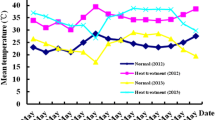Summary
For breeding early heading wheat cultivars with resistance to frost damage which are well adapted to dry areas of West Asia and North Africa, the relationships between winter hardiness, ear primordia development and heading traits, i.e. veernalization requirement, photoperiodic response and narrow-sense earliness, were assessed using a total of 30 genotypes of wheat (Triticum aestivum L.) grown in an experiment in Syria. The results of artificial freezing tests indicated that cultivars with good winter hardiness were to be found only in the winter wheat cultivars which required 50 or more days of vernalization treatment. These winter wheat cultivars did not initiate internode elongation without vernalization even at 95 days after planting. Thus their ear primordia were still underground and were protected from frost injury at this stage. Photoperiodic response and narrow-sense earliness were not associated with winter hardiness and earliness of internode elongation, but were related to the number of days to heading after planting. This indicated the possibility for breeding early heading cultivars with winter hardiness and tiller frost avoidance by combining high vernalization requirement, short narrow-sense earliness and neutral response to photoperiod.
Similar content being viewed by others
References
Andrews C.J., M.K. Pomeroy & I.A. De la Roche, 1974. Changes in cold hardiness of overwintering winter wheat. Can. J. Plant Sci. 54: 9–15.
Austin R.B., 1982. Crop characteristics and potential yield of wheat. J. Agric. Sci., Camb. 98: 447–453.
Baker C.K. & J.N. Gallagher, 1983. The development of winter wheat in the field. 1. Relationship between apical development and plant morphology within and between seasons. J. Agric. Sci., Camb. 101: 327–335.
Brule-Babel A.L. & D.B. Fowler, 1988. Genetic control of cold hardiness and vernalization requirement in winter wheat. Crop Sci. 28: 879–884.
Cahalan C. & C.N. Law, 1979. The genetical control of cold resistance and vernalization requirement in wheat. Heredity 42 (2): 125–132.
Fletcher R.J., 1988. Relationship between freezing injury suffered during stem elongation stage of development and vernalization response in a winter wheat cultivar (Triticum aestivum L. cv. Cheyenne). Aust. J. Agric. Res. 39: 129–140.
Fowler D.B. & R.J. Carles, 1979. Growth, development and cold tolerance of fall-acclimated cereal grains. Crop Sci. 19: 915–922.
Fowler D.B., L.V. Gusta & N.J. Tyler, 1981. Selection for winter-hardiness in wheat. III. Screening methods. Crop Sci. 21: 896–901.
Fujita M., R. Yoshikawa & K. Ujihara, 1990. Heading characteristics of early winter wheat strains in South Western area of Japan. (In Japanese) Japan J. Breed. 40 (Suppl. 2): 246–247.
Gullord M., C.R. Olien & E.H. Everson, 1975. Evaluation of freezing hardiness in winter wheat. Crop Sci. 15: 153–157.
Hoogendoorn J., 1985. The physiology of variation in the time of ear emergence among wheat varieties from different regions of the world. Euphytica 34: 559–571.
Hoshino T. & M. Tahir, 1987. Relationship between ear primordia development and growth attributes of wheat cultivars in dry areas of North Africa and West Asia. JARQ 21 (3): 226–232.
Inamura H., K. Suzuki & S. Nonaka, 1955. On the standard of successive stages of barley and wheat spike development. (In Japanese with English summary) J. Kanto-Tozan Agr. Exp. Stn. 8: 75–91.
Inamura H., I. Yamaga, K. Suzuki & M. Gokan, 1958. Study on the breeding of early varieties of wheat and barley. (I) Varietal differences of the early wheat and barley in the internode elongation in relation to the death of young ear by frost damage in early spring. (In Japanese with English summary) J. Kanto-Tozan Agr. Exp. Stn. 11: 20–28.
Kato K. & H. Yamagata, 1988. Methods of evaluation of chilling requirement and narrow-sense earliness of wheat cultivars. Japan J. Breed. 38 (2): 172–186.
Kato K. & S. Yamashita 1991. Varietal variation in photoperiodic response, chilling requirement and narrow-sense earliness and their relation to heading time in wheat (Triticum aestivum L.). Japan J. Breed. 41 (3): 475–484.
Keim D.L., J.R. Welsh & R.L. McConnel, 1973. Inheritance of photoperiodic response in winter and spring wheat cultivars of bread wheat. Can. J. Plant Sci. 53: 247–250.
Masle J., G. Doussinault & B. Sun, 1989. Response of wheat genotypes to temperature and photoperiod in natural conditions. Crop Sci. 29: 712–721.
Roberts D.W.A., 1990. Identification of loci on chromosome 5A of wheat involved in control of cold hardiness, vernalization, leaf length, rosette growth habit and height of hardened plants. Genome 33: 247–259.
Scarth R., E.J.M. Kirby & C.N. Law, 1985. Effects of the photoperiod gene Ppd1 and Ppd2 on growth and development of shoot apex in wheat. Annals of Botany 55: 351–359.
Sutka J. & J.W. Snape, 1989. Location of a gene for frost resistance on chromosome 5A of wheat. Euphytica 42: 41–44.
Warnes D.D. & V.A. Johnson, 1972. Crown-freezing and natural survival comparisons in winter wheat. Agronomy J. 64: 285–288.
Yasuda S. & H. Shimoyama, 1965. Analysis of internal factors influencing the heading time of wheat varieties. Ber. Ohara Inst. landw. Biol. 13: 23–38.
Yoshida, H., M. Kamio & K. Kawaguchi, 1983. Evolution of cultivars for early matureness in the Japanese wheat breeding. Proc. 6th Int. Wheat Genet. Symp. (Kyoto, Japan) 601–612.
Author information
Authors and Affiliations
Rights and permissions
About this article
Cite this article
Fujita, M., Kawada, N. & Tahir, M. Relationship between cold resistance, heading traits and ear primordia development of wheat cultivars. Euphytica 64, 123–130 (1992). https://doi.org/10.1007/BF00023545
Issue Date:
DOI: https://doi.org/10.1007/BF00023545




